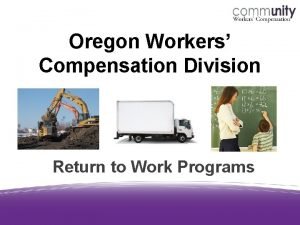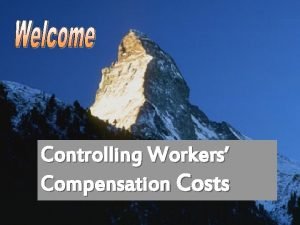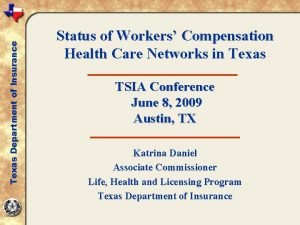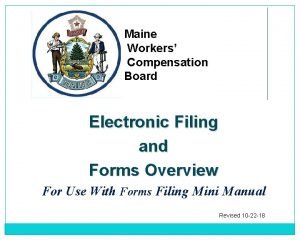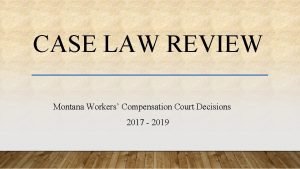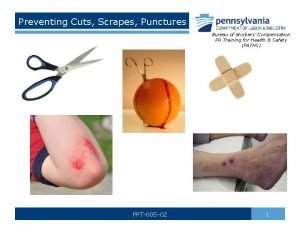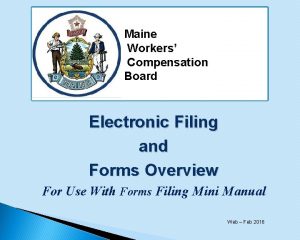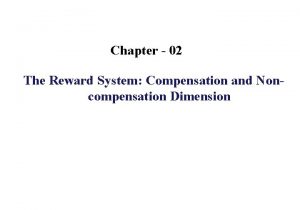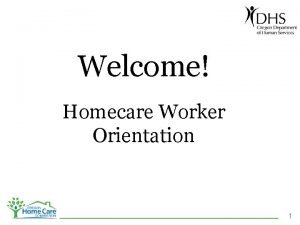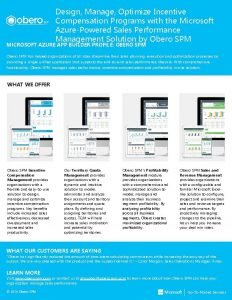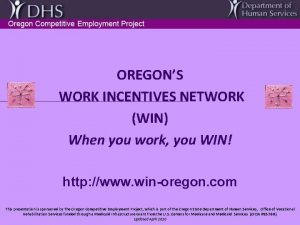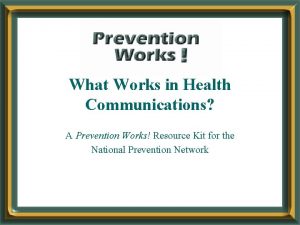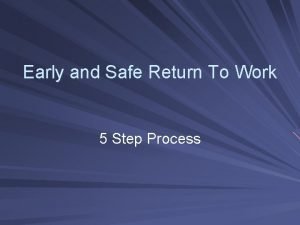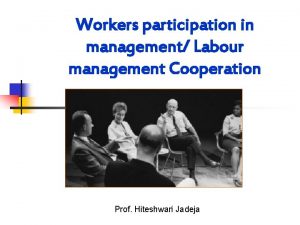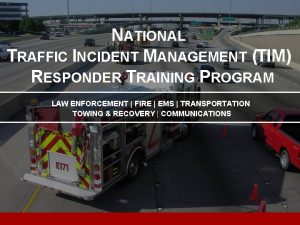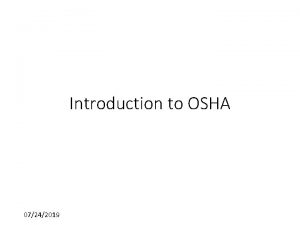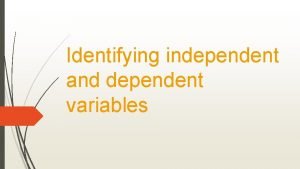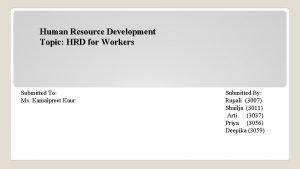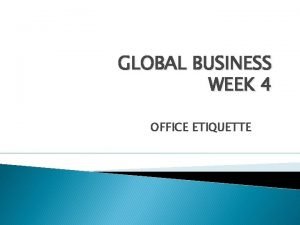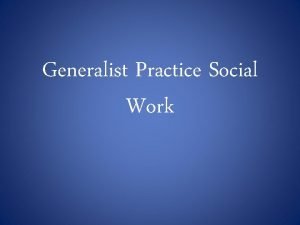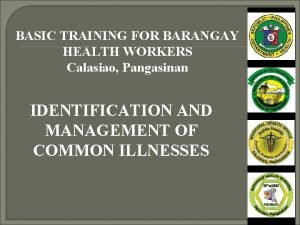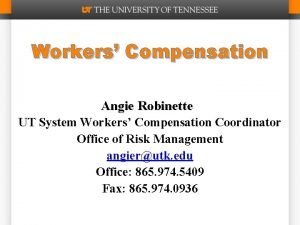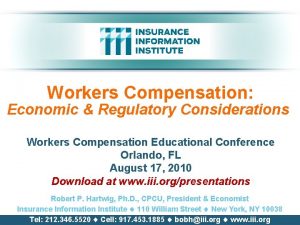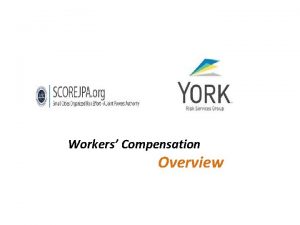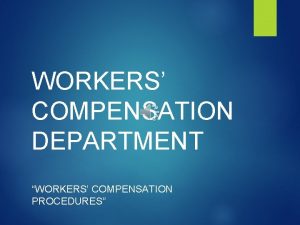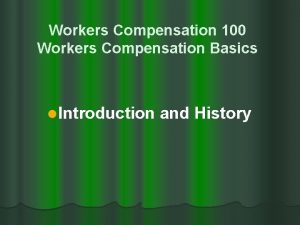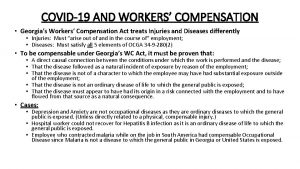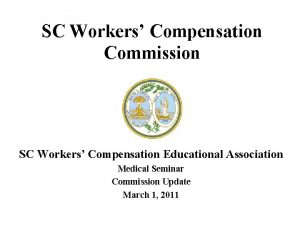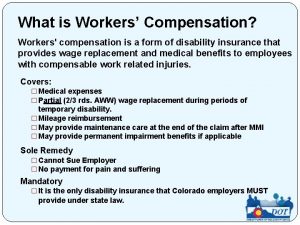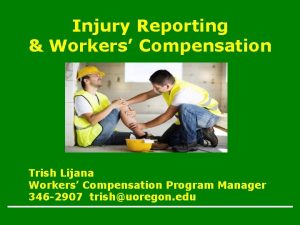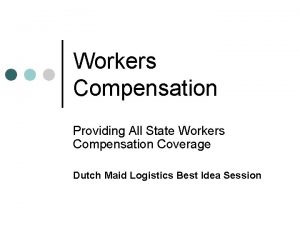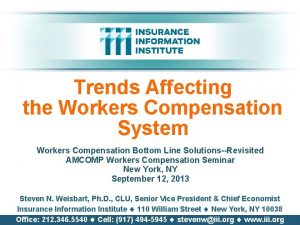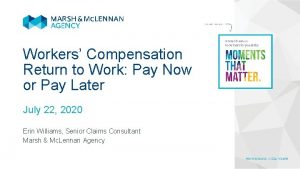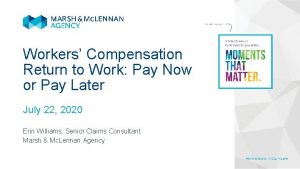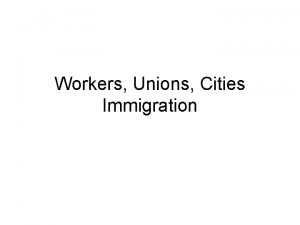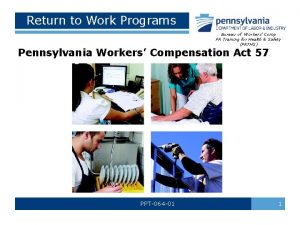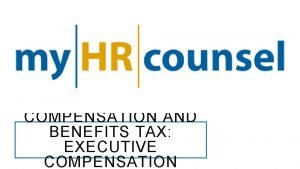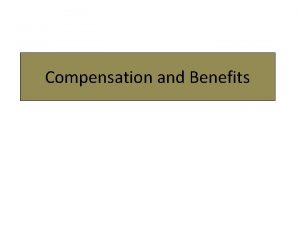Oregon Workers Compensation Division Return to Work Programs
































- Slides: 32

Oregon Workers’ Compensation Division Return to Work Programs

Employer at Injury Vocational Assistance Preferred Worker

How are they funded? The Workers´ Benefit Fund (WBF) a payroll assessment calculated on the basis of hours worked by all paid workers, owners, and officers covered by workers´ compensation insurance in Oregon, and by all workers subject to Oregon’s Workers´ Compensation Laws Currently $. 028 per hour worked split evenly between worker and employer.

Employer at Injury Program EAIP designed to encourage re-employment of qualified Oregon workers who incur injury-caused limitations from an on-the-job injury. Getting Oregon workers back on the job

Employer at Injury Program The purpose of EAIP is to: Enable the worker to perform transitional work within the worker’s limitations that resulted in the worker’s eligibility for the Employer-at. Injury Program; Prevent a worsening of the worker’s compensable injury or occupational disease; or If the claim has not been accepted or denied, prevent a worsening of the claimed workers’ compensation injury or occupational disease. Getting Oregon workers back on the job

Employer at Injury Program The insurer administers the program and must assist the employer in: • Obtaining from the medical service provider a medical release that meets the requirements EAIP rules • Identify a transitional work position Getting Oregon workers back on the job

Employer at Injury Program A transitional work plan must be created that is within the restrictions indicated on the worker’s medical release. Getting Oregon workers back on the job

Employer at Injury Program What is available to support the transitional work? Tools and Equipment – Needed for the job. Modification – Altering a worksite to allow the worker to perform their duties within their restrictions. Max $5000 combined with Tools Wage Subsidy - 45% of gross wages reimbursed. Max 66 days. Clothing – Clothing required for the work. Training – Tuition, books, and fees related to the work. Getting Oregon workers back on the job

Employer at Injury Program EAIP eligibility ends: • When the worker or employer no longer meets the eligibility provisions stated in OAR 436 -105 -0510 and 436 -105 -0511; • When the worker's claim is closed or denied; • When sanctions issued under OAR 436 -105 -0560 preclude eligibility; (4) When the insurer ends the Employer-at-Injury Program at any time while the worker’s claim is open; • Two years after the original date of acceptance of a nondisabling claim; or • When benefits under the Preferred Worker Program under OAR 436 -110 begin, including premium exemption but excluding claims costs reimbursed under OAR 436 -110 -0330. Getting Oregon workers back on the job

Vocational Assistance Retraining workers for suitable work

What is Vocational Assistance? Any of the services, goods, allowances, and temporary disability compensation under the Division 120 rules to assist an eligible worker return to work. This does not include determining a worker’s eligibility for vocational assistance. Retraining workers for suitable work

Vocational Assistance is administered and paid for by the insurer to workers who are found eligible. Retraining workers for suitable work

The objectives of vocational assistance To return the worker to employment which: • Pays a wage as close as possible to the worker’s wages at the time of injury, and • is physically suitable. Retraining workers for suitable work

When is the insurer required to determine vocational eligibility? Retraining workers for suitable work

The worker is medically stationary and has not been released to or returned to regular employment. The insurer receives information, prior to medically stationary status, that indicates the worker is likely eligible for vocational assistance. Eligibility was previously determined under current opening and the insurer has accepted a new condition. Retraining workers for suitable work

Eligibility Evaluation Must be completed and decision made in 30 days, with one extension of 30 days allowed. Retraining workers for suitable work

Administrative Review If the worker disagrees with the insurer’s decision, they can request a review from the Employment Services Team. Retraining workers for suitable work

Purpose of Review • Try to resolve disagreement through alternative dispute resolution. • If not, the vocational reviewer will issue a Director’s Review and Order. Retraining workers for suitable work

Two Categories of Vocational Assistance • Direct Employment Services • Training Retraining workers for suitable work

Development of Training Plan • Counselor must determine a suitable vocational goal Retraining workers for suitable work

Types of Training • • Basic Education On-the-job Training Occupational Skills Training Formal Training Retraining workers for suitable work

Completion of Training Four months of job placement assistance. Counselor monitors suitability of employment for 60 days Retraining workers for suitable work

For questions regarding Vocational Assistance: Katie Bruns 503 -947 -7816 Kristin Anderson 541 -618 -7910 Matt Ferrell 503 -947 -7690 Retraining workers for suitable work

Preferred Worker Program PWP encourages the re-employment of workers whose on-the-job injuries result in disability that may be a substantial obstacle to employment by providing assistance to eligible injured workers and to the employers who employ them. Returning Workers to work

Who are Preferred Workers? A person is designated a preferred worker because he or she has some measure of permanent work restrictions due to an accepted workers compensation claim that prevents return to their job at injury. The State of Oregon Workers’ Compensation Division has issued over 20, 000 Preferred Worker cards since 2000. This is a lifetime benefit and does not expire. Returning Workers to work

What does being a Preferred Worker mean? Returning Workers to work

They will be prepared to do the job Clothing benefit to assure that the worker has the necessary work clothes Tools and Equipment Provides the tools and equipment that an employer requires their workers to possess. Returning Workers to work Training Funding for training and certifications to give the preferred worker the skills to get the job done.

Other possible assistance Occupational Certifications Moving Miscellaneous Transportation Union Dues Returning Workers to work

Lowered employer costs and risk Wage Subsidy 50% of gross wages reimbursed for 6 months Premium Exemption An employer does not pay worker’s comp premiums or premium assessments on a preferred worker for three years. Claims cost reimbursement Protects the employer from the costs of a new claim if the preferred worker has a new injury during the three year exemption period. Returning Workers to work

Worksite Modification 2 Person Ladder Tire Dolly Panel Dolly Rebar Tier Tools, equipment, and worksite redesign needed to overcome injury-caused permanent restrictions so the preferred worker can do the job. Task Chair Returning Workers to work

Why do we offer these benefits an incentives? Returning Workers to work

For more information: Brian Nease Katie Bruns Worksite Modification Consultant Vocational Reviewer 503 -947 -7574 503 -947 -7812 brian. a. nease@oregon. gov Kathleen. r. bruns@oregon. gov For more information visit: www. oregonpwp. com
 Oregon workers compensation division
Oregon workers compensation division Controlling workers compensation costs
Controlling workers compensation costs Texas hcn workers compensation
Texas hcn workers compensation Maine workers compensation forms
Maine workers compensation forms Workers compensation fraud detection
Workers compensation fraud detection Liberty mutual insurance
Liberty mutual insurance Preventing cuts
Preventing cuts Maine workers compensation forms
Maine workers compensation forms Compensation and non compensation dimensions
Compensation and non compensation dimensions Homecare worker orientation
Homecare worker orientation Designing and managing incentive compensation programs
Designing and managing incentive compensation programs Disadvantages of waterfall model in software engineering
Disadvantages of waterfall model in software engineering Accelerated clinical trial agreement template
Accelerated clinical trial agreement template Work incentives network oregon
Work incentives network oregon Making health communication programs work
Making health communication programs work What jewelry can food handlers wear while working
What jewelry can food handlers wear while working Mcq on pl/sql
Mcq on pl/sql Early and safe return to work program
Early and safe return to work program 369 times 2
369 times 2 Long division synthetic division
Long division synthetic division Long division method
Long division method Syntheic divison
Syntheic divison Workers participation in management
Workers participation in management The mutcd states all workers
The mutcd states all workers Kingdom worker definition
Kingdom worker definition Topic 4 workers rights practice worksheet answer key
Topic 4 workers rights practice worksheet answer key Identify the independent variable and dependent variable
Identify the independent variable and dependent variable Hrd for workers
Hrd for workers Radiation dose limits for workers and public pdf
Radiation dose limits for workers and public pdf Office workers admit being rude
Office workers admit being rude Generalist intervention model engagement
Generalist intervention model engagement Workers participation in management
Workers participation in management Basic training for barangay health workers
Basic training for barangay health workers
